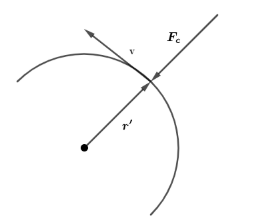
The direction of centripetal force is:
(A). Towards the centre of the circle and in the plane of the circle.
(B). Away from the centre of the circle and in the plane of the circle.
(C). Tangential to the circle.
(D). Perpendicular to the plane of the circle.
Answer
590.1k+ views
Hint: The centripetal force can be given by the expression: $Fc=m\dfrac{{{v}^{2}}}{r}$. Now, considering the direction of velocity v, the direction of force acting can be determined.
Complete step-by-step answer:
As given in the question we have to find the direction of centripetal force which can be derived by considering the relation between velocity and force acting. Now, the centripetal force acting can be given by the formula:
$Fc=m\dfrac{{{v}^{2}}}{r}$

Now, from the above figure we can understand the direction of velocity, which is tangential to the circle or curvature of the path.
As we know that the acceleration is always perpendicular to direction of velocity, so, we can say that centripetal acceleration is perpendicular to the circle.
Now, from Newton's second law of motion i.e. $F=ma$, we can say that direction of force is in the direction of acceleration or parallel to it.
So, here also the direction of centripetal force will be parallel to centripetal acceleration. Hence, it can be said that the direction of centripetal force is perpendicular to the circle of curvature of the path and acts towards the centre as its direction of centripetal acceleration acts perpendicular to the velocity.
Now, as the acceleration is in the same plane of the circle the force also acts in the same plane on the circle.
Thus, option (a) is correct.
Note: For solving such problems students must consider the relation between angular velocity, angular acceleration and centripetal force. Students should not get confused between centrifugal and centripetal force, as centrifugal force acts outwards direction and away from the centre. So, if a student considers the centrifugal and centripetal force as the same then the solution will be wrong. So, basic concepts should be kept in mind by the students while solving such problems.
Complete step-by-step answer:
As given in the question we have to find the direction of centripetal force which can be derived by considering the relation between velocity and force acting. Now, the centripetal force acting can be given by the formula:
$Fc=m\dfrac{{{v}^{2}}}{r}$

Now, from the above figure we can understand the direction of velocity, which is tangential to the circle or curvature of the path.
As we know that the acceleration is always perpendicular to direction of velocity, so, we can say that centripetal acceleration is perpendicular to the circle.
Now, from Newton's second law of motion i.e. $F=ma$, we can say that direction of force is in the direction of acceleration or parallel to it.
So, here also the direction of centripetal force will be parallel to centripetal acceleration. Hence, it can be said that the direction of centripetal force is perpendicular to the circle of curvature of the path and acts towards the centre as its direction of centripetal acceleration acts perpendicular to the velocity.
Now, as the acceleration is in the same plane of the circle the force also acts in the same plane on the circle.
Thus, option (a) is correct.
Note: For solving such problems students must consider the relation between angular velocity, angular acceleration and centripetal force. Students should not get confused between centrifugal and centripetal force, as centrifugal force acts outwards direction and away from the centre. So, if a student considers the centrifugal and centripetal force as the same then the solution will be wrong. So, basic concepts should be kept in mind by the students while solving such problems.
Recently Updated Pages
Master Class 11 Economics: Engaging Questions & Answers for Success

Master Class 11 English: Engaging Questions & Answers for Success

Master Class 11 Social Science: Engaging Questions & Answers for Success

Master Class 11 Biology: Engaging Questions & Answers for Success

Class 11 Question and Answer - Your Ultimate Solutions Guide

Master Class 11 Business Studies: Engaging Questions & Answers for Success

Trending doubts
10 examples of friction in our daily life

One Metric ton is equal to kg A 10000 B 1000 C 100 class 11 physics CBSE

Difference Between Prokaryotic Cells and Eukaryotic Cells

1 Quintal is equal to a 110 kg b 10 kg c 100kg d 1000 class 11 physics CBSE

State the laws of reflection of light

Explain zero factorial class 11 maths CBSE




